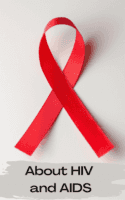UNDERSTANDING HIV AND AIDS
HIV, the human immunodeficiency virus, is an organism that survives in human cells.These cells are present in body fluids such as blood, sexual fluids and breast milk. The virus attaches to a specific type of cell (the CD4 cell) that is part of the immune system and responsible for helping the body fight off infection.
When a CD4 cell is infected with HIV, the virus goes through multiple steps to reproduce itself and create many copies of itself. This means that the amount of virus in the body (the viral load) increases, and the body’s immune system cells (the CD 4 count) gets lower. The virus then overwhelms the immune system, which cannot fight off other opportunistic infections.
A person can live with HIV for many years without getting sick depending on their exposure to other illnesses and infections. During this time, they can transmit the virus to others. When a person’s viral load of HIV begins to rise and their CD4 cell count begins to drop, they may begin to get other related infections.
AIDS, the acquired immunodeficiency syndrome, is a term used to describe a collection of illnesses that occur because the immune system has been weakened by HIV.
Treatment with antiretroviral drugs (ARVs) can assist the immune system in recovering to the point where a person living with HIV has no symptoms. If a person has access to treatment with ARVs then they will most likely never get AIDS, although they will always be living with HIV.
HOW HIV IS TRANSMITTED FROM ONE PERSON TO ANOTHER
HIV can enter the body in different ways:
Through sexual contact with a person who has HIV: HIV lives in the sexual fluids of both men and women. These include semen (cum) and the clear liquid called pre-cum that is present before a man ejaculates, as well as in the vaginal fluids of a woman. When these fluids come in to contact with cuts or tears in the skin or soft internal tissues, then the virus can pass from one person to another.
From a pregnant woman to her child: HIV is passed to a child through the placenta that is fed with the blood of the mother in the womb, through contact with the mother’s blood during childbirth or through breastfeeding, if a mother with HIV mixes breastfeeding with formula feeding. Feeding a baby with breast milk only is safe and recommended for the first six months if a mother has HIV and does not mix breastfeeding with other feeding methods. If the mother is taking ARVs and the baby is HIV negative, then the mother can breastfeed for at least 12 months and up to 24 months or longer if she is adherent to the treatment.
By injection with a needle or a cut with a razor that has infected blood in or on it: People who inject drugs and share needles or people like doctors or nurses who are accidently pricked with needles that have blood on them can be infected with HIV as the virus in the blood is transmitted directly into the bloodstream. The same kind of transmission can happen when a person is cut or nicked with a razor that has HIV-infected blood on it.
Through blood transfusions with infected blood or organ donation by a person with HIV: HIV is present in the blood and organs of a person who is infected with HIV and, if they donate blood or organs, these can also be infected. In South Africa, all blood and organ donors are screened and tested for HIV, so this risk of transmission is rare.
PREVENTING HIV INFECTION
The only way to prevent HIV infection is to avoid contact with HIV-infected blood or other body fluids.
If you have HIV or your partner has HIV, you should use a condom carefully every time you have sex.
If you touch a person who is bleeding, you should avoid direct skin contact with the blood by using latex gloves. If gloves are not available, you can use absorbent clothing or plastic bags to prevent skin-blood contact. The same precautions should be used if caring for a person who has HIV and cleaning up any urine, faeces or vomit that has visible blood in it.
Sweat, tears and nasal mucous do not carry HIV.
A mother can prevent transmitting HIV to a child through taking ARVs during the pregnancy, and through the baby being given ARVs when he or she is born. A mother who is on ARVs will also not transmit HIV to her baby when she is breastfeeding. It is possible to have a healthy baby even if the mother or the father, or both, are HIV positive.
TESTING FOR HIV
The only way to know if you have HIV is to have a blood test yourself. This test can be done free of charge in most clinics.
You need to wait for at least one month, and it is advisable to wait for three months after having had unprotected sex or other contact with blood or other body fluids before you test, because of the window period.
The window period is the time frame between coming into contact with HIV and the appearance of antibodies that have responded to the virus. During this period, an HIV test will not pick up that you are infected with HIV, as your immune system has not yet produced the antibodies that fight the virus. During the window period, if you have already been infected with HIV, you are very infectious and may unknowingly infect other people.
TREATMENT FOR HIV
Many countries have adopted a Universal Test and Treat (UTT) policy, which means that as soon as you test positive for HIV, you are started on treatment with ARVs, which make up a treatment known as ART. ARVs work by stopping HIV from taking over the body’s CD4 cells to make more HIV. When ARVs are taken properly, an HIV-positive person’s viral load goes down, which means there is less HIV in the blood and body. At the same time, the CD4 count goes up and the immune system recovers and becomes strong again. When you have started on treatment, you will be counselled on taking it and coping with any side effects. You will be asked to return to the clinic regularly to collect your medicine, will be screened for TB symptoms and any other opportunistic infections, and will be asked if you are experiencing any side effects.
Regular follow-up testing is required in the first few months of starting treatment. Your CD4 count and viral load will be tested after six months and again at 12 months, to monitor your response to the ARVs and to identify any treatment failures and problems with adherence. It is also important to have liver-function tests when on ARVs.
ART is for life, and taking it incorrectly can cause serious health problems, like drug resistance, which makes HIV immune to the medication given and more difficult to treat. It is therefore very important that you take your ARVs as prescribed by your healthcare worker.
HIV PREVENTION THROUGH TREATMENT
Post-Exposure-Prophylaxis (PEP): PEP is a 28-day course of antiretroviral drugs which is given after the exposure to HIV and can help prevent HIV from developing in the system. PEP is only effective if taken within 72 hours (three days) of the incident, as this is how long it takes for HIV to get into the system. It is more effective if taken as soon as possible after the contact.
In most countries, PEP is available at clinics or hospitals to any person who is HIV negative and has been exposed to HIV in any way, including through rape or unprotected sex. Pre-Exposure Prophylaxis (PrEP): PrEP is the use of ARVs to reduce the risk of HIV infection in people who are HIV-negative. This is useful as a prevention method for people who are in relationships with an HIV-positive partner. PrEP is only effective when taken every day for 20 days before having sex. It is recommended that a person using PrEP continues taking the tablets for 28 days (four weeks) after the last exposure to sex, to ensure that the treatment is effective.
People who use PrEP must commit to taking the drug every day and seeing their healthcare provider for follow-up checks every three months. In some countries, PrEP is free, but in some places, it is only available through private doctors.
LIVING POSITIVELY WITH HIV
Living positively is a term used to describe how to cope well with HIV, whether you are HIV positive or negative. It means taking care of yourself on all levels of well-being.
If you are HIV positive, you will need to:
• Take your ARV treatment as prescribed;
• Look out for any other infections and get treated early;
• Eat a balanced diet;
• Drink eight glasses of clean, safe water every day;
• Take regular exercise;
• Get plenty of rest;
• Cut down or stop smoking and using alcohol or drugs;
• Take care of your emotional well-being and get support from trusted friends or family or
a support group; and
• Make sure that you protect others from HIV infection by using a condom every time you have sex.
If you are HIV negative, you will need to:
• Follow all of the tips noted above about taking care of yourself;
• Find ways to offer support to those who you know are HIV positive; and
• Make sure that you protect yourself from HIV infection by using a condom every time you have sex.
ADDRESSING STIGMA AROUND HIV
Because HIV is often related to sexual behaviour, which is a taboo topic in many communities, there is often secrecy around HIV. This can lead to people having negative opinions about those living with HIV, and discrimination, where HIV-positive people are treated badly.
To reduce stigma in your community, you can:
• Talk openly about HIV;
• Educate yourself and others about what living with HIV means; and
• Challenge discrimination when you see it.
This information was compiled by the DREAMS Thina Abantu Abasha Programme. You can find them on Facebook here and on Instagram here. Their WhatsApp number is 0714481057.



